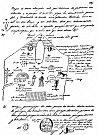
Sacred Texts Earth Mysteries Index Previous Next

THERE IS ANOTHER "SQUARE EARTH" shown in one of the rarer world-pictures in this collection--the Universe of the ancient Peruvians. Juan de Santa Cruz Pachacuti Yamqui Salcamayha, a native Peruvian, left the drawing in his Account of the Antiquities of Peru, written about 1620. His manuscript reached Spain, where it lay long forgotten among the treasures of the Biblioteca Nacional at Madrid. Salcamayha was not only a Peruvian, but he is credited with being one of the chosen recipients of the traditions of his people, and in close touch with the final glories of the Ynca empire; for his great-grandparents were living at the time of the Spanish conquest of Peru, and stories of the vanished days came to him almost from the lips of those who had witnessed them.
Salcamayha left no reading of this crudely sketched cosmos, and what follows is based largely on Beuchat's interpretation.
The World, says Beuchat, 1 was called Pacha. It was a square World, with a roof indicated, ridge-shaped, where dwelt the great God. The lowest plane was Earth, which gave support to the four quarters where dwelt the gods.
Outside the World, above it, to the left, is a small disc, so Beuchat calls it, but it far more resembles a figure of the Cosmic or Mundane Egg, surrounded, though not en-circled, by five stars. Within, in the centre of the pointed roof, this outer design appears again, much enlarged, slightly rearranged, and with the addition of a single star. In the rearrangement of the design, three of the stars have

Click to enlarge
FIGURE 79. World-picture of the ancient Peruvians. In
been connected along a thread, and from these three is suspended the oval figure of Huiracocha, the Creator of the World. On his left is the Sun or Inti; on his right the Moon or Quilla. The bright star below the Sun is Chasca or the planet Venus, and under Venus lies a star representing Catachillay, or the Milky Way. Between the Milky Way and Venus is a group of stars--thirteen--which are the constellations.
Below Huiracocha are five stars, but arranged differently from the group above. One is separated entirely from the other four, but the four are united by crossed lines. Beuchat ventures to believe that these also represent constellations.
Beneath the Milky Way, Catachillay, are a number of concentric semi-circles, which signify the Rainbow; the two wave-lines at the left are Thunder, and below them is the River Pillcomayo. To the right of the river and immediately beneath the rainbowed circle are "eyes," "dont," says Beuchat, "on ne voit point clairmant la signification." Far to the right is an irregular figure labelled mamacocha--"the sea," says Beuchat, and a little above it a black puma. Below these two is mallqui, "a tree." At the bottom of the picture is a rectangle, which represents Coricancha, and above the figures of a man and a woman.
In his manuscript Salcamayha explains Coricancha, accompanying the text with another oval "creation" figure. A certain Ynca, he says, after he and his people had settled at Coricancha on whose site was reared the Temple of the Sun, "ordered the smiths to make a flat plate of fine gold, which signified that there was a Creator of Heaven and
[paragraph continues] Earth, and that it was of this shape. He caused it to be fixed in a great house, called Couricancha pachaya-chachipac huasin," which is to say, "the golden place, the house of the teacher of the world."
Another reading of this world-picture gives some interesting literal translations of some of the old Indian and Spanish text. Outside of the diagram are two Indian words, Uamado and Orcorara, followed by a bit of Spanish commentary--"which is to say (quiere decir) three stars all equal." Inside the figure at the peak of the "roof," mingled with the Sun and Moon are many Indian words, with a Spanish translation outside: "Which is to say that this is the image, or pattern, of the maker of both heaven and earth; yet this plate was simply (or crudely) (made) and not to be perceived (easily by all), because there was a lack in all the tablet (or design) of the radiance of the resurrection of Jesus the Lord."
"Lucera" written about the star Chasca, beneath the Sun, and designated by Beuchat as Venus, is a Spanish word meaning "luminous stars," as differing from fixed stars, and is applied to Venus as the morning, and to "Lucifer" as the evening, star. Under Chasca are Indian words and, in Spanish, "This is the luminous star of the morning." To the right, the star beneath the Moon carries several Indian words and, in Spanish, "This is the Evening (star)."
The five stars below Huiracocha are designated by two Indian words, Saramania and Chacana, followed by "en general." "Perhaps they mean Cosmogony, but this is only a guess."
The group of thirteen stars signify "summer season." And the corresponding design at the right reads "Clouds in winter (season)." The two wave-lines at the extreme left are in this reading, "Lightning." To their right, the Rainbow, above "El mundo o la tierra"--"the world or the earth."
The seven "eyes" under the "world" are said here to be Indian words.
The "black puma" above the Tree of Life is said to signify hail, "and since hail is bad for crops, they represent it by a little animal."
185:1 Manuel d’Archeologie américaine: H. Beuchat, 1912, pp. 630-631.